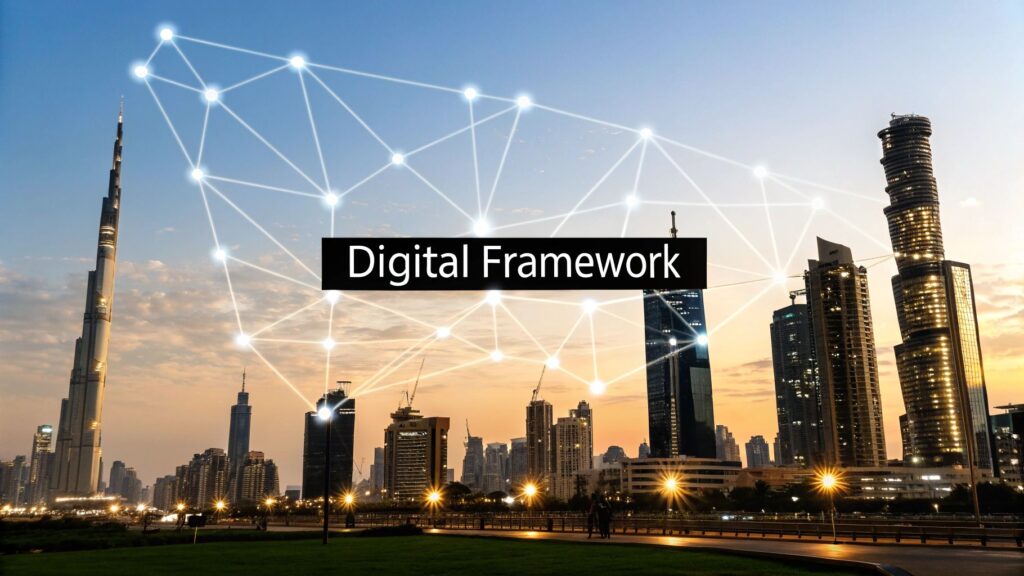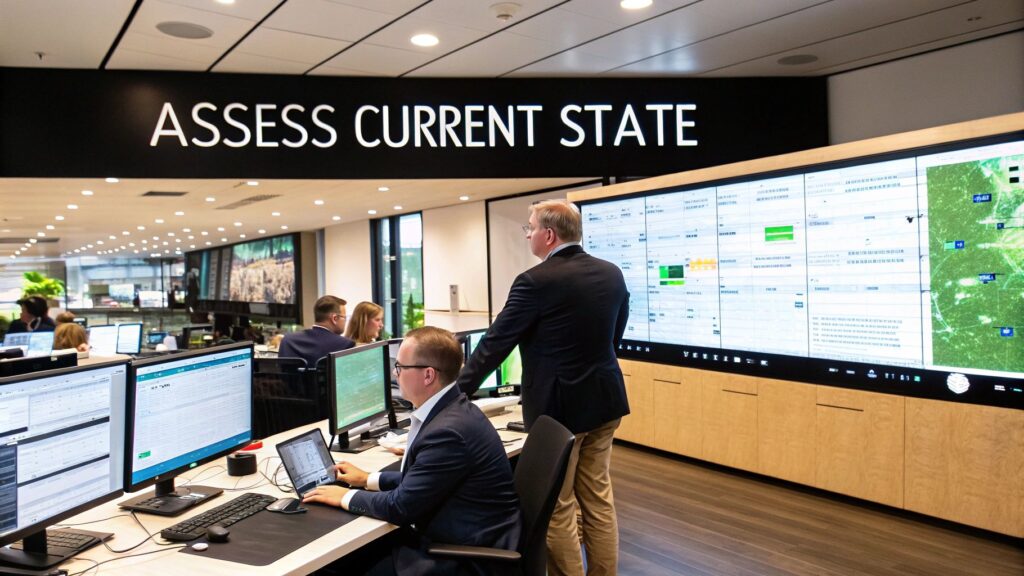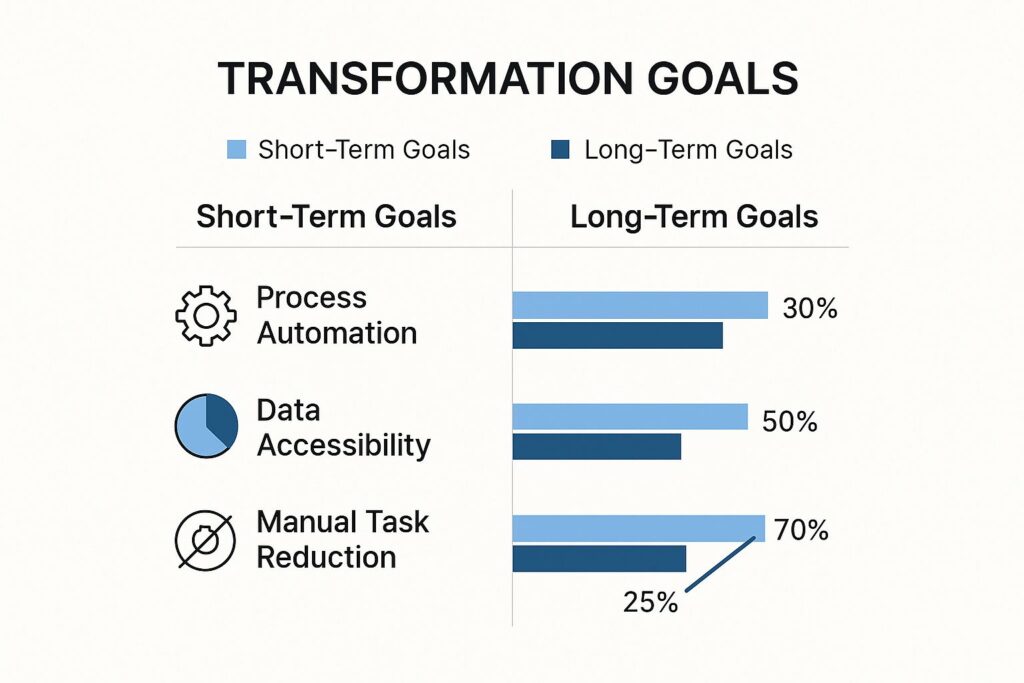
Navigating Digital Transformation in the Middle East Landscape

The Middle East presents a unique set of opportunities and challenges when it comes to digital evolution. While existing digital transformation frameworks provide helpful guidance, applying them without considering the region’s specific nuances can hinder progress. This section explores how regional dynamics, particularly in the UAE, require a specialized approach to UAE digital transformation framework. Understanding these nuances is crucial for achieving success.
Cultural factors, for instance, heavily influence technology adoption and user behavior. Strategies, therefore, must align with local values and preferences to be truly effective.
Cultural Considerations in Digital Transformation
Cultural nuances in the Middle East affect every aspect of digital transformation, from initial planning through to implementation. Communication styles and decision-making processes, for example, can vary greatly compared to Western norms.
Additionally, different levels of digital literacy across demographics necessitate targeted training and support programs. This inclusive approach helps to maximize the benefits of digital initiatives for everyone. These cultural elements are not obstacles but rather key considerations for shaping region-specific transformation frameworks.
Regulatory Environment and Market Expectations
The regulatory landscape of the Middle East, particularly surrounding data privacy and cybersecurity, is another factor that shapes digital transformation implementation. Market expectations in the region often prioritize localized solutions and services.
This emphasizes the need to address data sovereignty and compliance. Successfully navigating these factors builds trust and enables sustainable growth within the regional digital ecosystem.
The digital transformation market in the Middle East and Africa (MEA) is experiencing significant growth. Generating approximately USD 46.56 billion in revenue in 2024, the market is projected to expand at a CAGR of 30.2% from 2025 to 2030. This growth is fueled by factors like increased adoption of cloud computing, AI, and smart city initiatives.
The UAE, a regional hub, benefits significantly from this expansion, with government programs like Dubai Internet City promoting digital innovation. This underscores the importance of strong digital transformation frameworks for directing investments and maximizing opportunities.
Building a Successful Digital Transformation Framework in the UAE
Creating a digital transformation framework for the UAE demands careful consideration. It involves adapting global best practices to the specific context of the region, including an understanding of local culture, regulations, and market dynamics. The following table offers insights into the projected market growth:
To illustrate the market expansion, let’s take a look at the following data:
| Metric | Value | Impact Factor |
| 2024 Market Revenue | USD 46.56 billion | Baseline |
| Projected CAGR (2025-2030) | 30.2% | Significant Growth Indicator |
| Key Drivers | Cloud Computing, AI, Smart City Initiatives | Technological Advancement |
This table, “Digital Transformation Market Growth in MEA Region,” presents key statistics demonstrating the expansion of digital transformation across Middle Eastern markets. The strong projected CAGR highlights the significant growth potential in the region.
Here are some key elements for successful framework development:
- Contextualization: Adapting global frameworks to align with the specific cultural, regulatory, and economic environment of the UAE.
- Stakeholder Engagement: Involving local communities, businesses, and government agencies in the planning and implementation stages.
- Talent Development: Investing in training and education to equip the workforce with the necessary skills for digital transformation.
- Infrastructure Investment: Creating a robust digital infrastructure, which includes high-speed internet access and data centers, to facilitate digital services.
- Innovation Focus: Fostering a culture of innovation and experimentation to create new digital solutions and business models.
By focusing on these elements, organizations in the UAE can effectively use digital transformation frameworks to achieve sustainable growth and improve competitiveness. This requires an ongoing commitment to adaptation and a willingness to embrace new technologies and strategies. The potential rewards, however, are significant, promising a future of innovation and prosperity for the region.
The Building Blocks of a UAE-Optimized Framework

The infographic above illustrates the path to digital transformation, highlighting both short-term and long-term objectives. The focus is on key areas like process automation, improving data accessibility, and reducing manual tasks. Initial gains of 30% in process automation and 25% in manual task reduction, as shown, establish a solid foundation for more ambitious future targets. This phased approach allows organizations to demonstrate early value and secure buy-in for continued investment.
Successfully transforming an organization digitally in the UAE goes beyond simply replicating Western models. It necessitates understanding the nuances of the region. This includes acknowledging how local culture, regulatory environments, and market dynamics influence how technology is adopted and implemented. Let’s delve into the core components that contribute to a successful digital transformation framework within the UAE.
Governance and Leadership
Effective governance provides the essential structure and oversight for successful digital transformation. In the UAE, this often involves modifying existing organizational structures to incorporate new roles and responsibilities centered around digital strategies. Creating a dedicated Digital Transformation Office, for instance, can centralize knowledge and streamline decision-making. Strong leadership, fully committed to the long-term vision, is vital for driving this organizational change and ensuring cross-departmental alignment.
Having strong leadership ensures that everyone is moving in the same direction and working towards the same digital future. This top-down approach sets the tone for the entire transformation journey.
Stakeholder Engagement
Securing buy-in from all stakeholders is paramount. This includes engaging with employees across all levels, as well as collaborating with external partners and clients. Relationship building holds particular importance in the UAE. Open communication and transparency in decision-making are key for fostering trust and encouraging participation. This collaborative approach ensures everyone’s needs are considered within the digital transformation framework.
By actively involving stakeholders, the digital transformation framework becomes a product of collective effort, leading to greater ownership and successful implementation.
Cultural Change Management
Digital transformation frequently requires significant adjustments to working styles and perspectives. Addressing potential resistance to these changes is crucial. Clearly communicating the benefits of transformation and offering adequate training and support to employees are important steps. Respecting cultural sensitivities is especially critical in the UAE. Aligning change management strategies with local values and practices enhances the prospect of a successful shift.
Addressing cultural considerations within the transformation strategy helps smooth the transition and ensures that new technologies and processes are embraced.
Adapting to Regional Regulations
The UAE has specific legal requirements for data privacy, cybersecurity, and digital content. Any framework must operate within these parameters. This can involve implementing stringent security measures and making sure all online activities are compliant with local laws. For example, organizations must consider data sovereignty rules when selecting cloud service providers. Understanding these requirements safeguards organizations against legal repercussions and strengthens public trust.
Measuring Success with Relevant KPIs
Defining and monitoring Key Performance Indicators (KPIs) is essential for evaluating the effectiveness of any digital transformation initiative. Simply applying KPIs used in other regions might not be enough. UAE organizations should identify KPIs aligned with their business goals and the specific conditions of the local market. These metrics might include customer satisfaction, efficiency gains, or increased revenue. Tailored KPIs offer a more precise assessment of progress and allow for informed decision-making.
To illustrate the core framework components and regional adaptations we have constructed a comparison table to highlight key similarities and differences:
| Framework Component | Western Approach | Middle East Adaptation | Implementation Considerations |
| Governance & Leadership | Centralized, top-down approach | Collaborative, consensus-driven | Adapting organizational structures |
| Stakeholder Engagement | Focus on individual contributions | Emphasis on relationship building | Transparent communication & decision-making |
| Cultural Change Management | Standardized processes | Culturally sensitive strategies | Addressing potential resistance proactively |
| Regional Regulations | GDPR, CCPA compliance | UAE data privacy and cybersecurity laws | Data sovereignty and local content regulations |
| Measuring Success | Global benchmarks and KPIs | Region-specific KPIs | Aligning metrics with business objectives and market context |
This table summarizes the key distinctions between Western and Middle Eastern approaches to digital transformation, with a focus on adapting the framework to the UAE context. It highlights the need for cultural sensitivity, regulatory compliance, and the importance of customizing metrics to ensure the success of digital transformation initiatives within the region.
By integrating these key building blocks, organizations in the UAE can construct robust and effective digital transformation frameworks that drive meaningful outcomes and contribute to sustained success in the dynamic regional market. This strategic approach helps ensure technological advancements are implemented sustainably within the unique UAE landscape.
Data Infrastructure: The Transformation Foundation

A solid data infrastructure is the bedrock of any successful digital transformation. This is particularly true in the UAE, a nation leading the way in digital innovation within the Middle East. This section explores how UAE organizations are building their data infrastructure to empower these transformative initiatives. It’s about establishing a strong base that supports, rather than hinders, digital progress.
Building a Robust and Scalable Data Infrastructure
Data infrastructure encompasses more than just hardware; it’s a complete ecosystem. This includes data centers, networks, cloud platforms like AWS, Azure and Google Cloud, and the essential software used for managing and analyzing data. Building a robust data infrastructure requires careful consideration of several key factors.
Organizations must select the right combination of on-premise and cloud solutions to address their unique requirements. They must also prioritize strong security measures to protect sensitive data. This not only safeguards valuable information, but also builds and maintains customer trust.
Scalability is also critical. As organizations grow and expand their digital initiatives, the data infrastructure must be able to handle increasing data volumes. This often necessitates strategic planning and investment in flexible, expandable solutions.
Navigating Data Sovereignty and Global Integration
Data sovereignty is a primary concern for organizations operating in the UAE. Regulations mandate that specific data types be stored within the country’s borders. This can pose a challenge for multinational companies with global operations.
However, regional leaders are successfully navigating these requirements while maintaining global integration. This often involves setting up local data centers while ensuring seamless connections to global networks. This approach ensures compliance with local laws while maintaining vital global market connections.
Some organizations leverage hybrid cloud models, combining public cloud services with private cloud or on-premise solutions for data subject to sovereignty regulations. This allows them to enjoy the flexibility and scalability of the cloud while remaining compliant.
The growth of data centers throughout the Middle East highlights the essential role of data infrastructure in digital transformation. This expansion is fueled by factors such as the rise of smart city projects, increasing adoption of AI, and the growing demand for cloud services.
Supporting Emerging AI Initiatives
AI is a major catalyst for digital transformation, and it demands significant data infrastructure. UAE organizations are investing heavily in hyperscale data centers to support AI-driven analytics and machine learning. These data centers provide the necessary computing power and storage capacity for processing and analyzing vast datasets.
This investment allows businesses to derive valuable insights from their data and develop innovative AI-powered applications. Furthermore, organizations are structuring their data ecosystems with AI in mind. This includes focusing on data quality, establishing effective data pipelines, and implementing data governance frameworks.
This strategic approach allows businesses to harness the full power of AI for growth and innovation. It streamlines AI integration into existing operations and future-proofs the business for further AI advancements.
Avoiding Common Infrastructure Pitfalls
While a robust data infrastructure is essential, there are common pitfalls to avoid. One such pitfall is underestimating the importance of data governance. Without clear policies and procedures for data management, organizations face the risk of data silos, inconsistencies, and security vulnerabilities.
Another frequent mistake is overlooking the human element. Investing in training and development for IT staff is crucial for effectively managing an increasingly complex data infrastructure. Without skilled professionals, organizations cannot fully realize the value of their infrastructure investments. This requires continuous learning and development to keep pace with technological advancements. Skilled IT professionals are vital to successful digital transformation.
Breaking Through Legacy Barriers With Regional Solutions
Digital transformation in the UAE offers significant growth potential, but it also comes with its own set of challenges. These often arise from existing legacy systems and processes that don’t easily integrate with modern digital solutions. This section explores these common obstacles and offers insights from transformation leaders in the Middle East on how they are overcoming them.
Addressing Regional Talent Gaps
One of the biggest hurdles is the scarcity of skilled professionals needed to drive digital transformation initiatives. Finding individuals with proficiency in areas like AI, cloud computing, and cybersecurity can be challenging in the region. Successful companies are tackling this talent gap through several key strategies:
- Investing in Training and Upskilling: Existing employees are being trained in the latest technologies through partnerships with educational institutions and specialized training programs. This approach builds a skilled workforce from within.
- Attracting International Talent: Companies are also actively recruiting experienced professionals from other regions with expertise in specific digital fields. This brings in valuable knowledge and enhances local capabilities.
- Supporting Local Educational Initiatives: Organizations are collaborating with universities and colleges to develop specialized curricula focused on digital skills. This ensures a future pipeline of qualified professionals.
Navigating Complex System Integrations
Integrating new digital solutions with existing legacy infrastructure is a complex undertaking. The challenge often lies in balancing the need for innovation while minimizing disruption to current operations.
Many businesses in the region rely on older systems that are deeply embedded in their workflows. Replacing these systems outright is often not feasible due to cost or operational constraints. As a result, successful organizations are employing strategic integration approaches:
- Phased Rollouts: Implementing new systems in stages, starting with less critical functions, allows organizations to test and refine their integration processes. This phased approach minimizes risk and maintains business continuity.
- API-Driven Integration: Application Programming Interfaces (APIs) are being used to connect newer digital tools with older systems. This bridges the gap between legacy infrastructure and modern solutions without requiring a complete overhaul.
- Hybrid Cloud Strategies: Organizations are adopting hybrid cloud models, leveraging cloud computing for some functions while keeping sensitive data within their own on-premise infrastructure. This approach balances security and compliance needs with access to innovative cloud solutions.
In the banking sector, these frameworks are especially critical. Over 75% of banks in the region cite legacy infrastructure as a major impediment to their digital goals. They are finding that a balanced approach, merging new platforms with existing systems, is essential for managing risk while pursuing innovation.
Introducing new technologies and processes often encounters resistance from employees accustomed to existing ways of working. This cultural aspect of digital transformation is often underestimated, but it’s crucial for success in the UAE. Organizations are addressing this challenge by focusing on:
- Open Communication and Transparency: Clearly explaining the reasons for change and the benefits it will bring to the organization is essential for alleviating anxieties and building support for the transformation.
- Employee Involvement and Feedback: Including employees in the planning and implementation process fosters a sense of ownership and makes them more receptive to new technologies. This collaborative approach leads to smoother transitions.
- Targeted Training and Support: Providing employees with the training and resources they need to use new tools and technologies empowers them to adapt to and embrace the transformation process.
By addressing these core challenges—talent gaps, complex system integration, and cultural resistance—organizations in the Middle East are creating a foundation for successful and sustainable digital transformation. They are building frameworks that not only embrace the opportunities presented by new technologies but also address the unique regional context in which they operate. This strategic approach allows for both current progress and future adaptability.
Your Transformation Roadmap: From Strategy to Reality

A well-defined digital transformation framework is essential for achieving meaningful and sustainable change. This section offers a practical, step-by-step guide for organizations in the UAE, helping translate strategic goals into tangible outcomes. We’ll explore the experiences of successful companies in the region to highlight how a structured approach can simplify the complexities of digital transformation.
Defining Realistic Timelines and Resource Allocation
Start by breaking down your overall digital transformation vision into smaller, more manageable phases. Each phase should have specific objectives, clearly defined deliverables, and realistic deadlines. This phased approach allows for greater control, quicker feedback, and adjustments along the way.
Resource allocation, including both finances and human capital, requires careful planning. Ensure alignment between your budget, your team’s skillsets, and the needs of each transformation phase.
For instance, if your initial phase involves implementing a new CRM system, allocate sufficient funds for software licenses, training, and integration support from experts like FSI Technology. Make sure your team has the necessary skills to manage the new system effectively.
Implementing Effective Governance Models
Establishing clear governance is critical for maintaining momentum and accountability. Define roles, responsibilities, and decision-making processes for your digital transformation initiatives.
A dedicated steering committee of key stakeholders can oversee progress, track performance, and ensure alignment with overarching business objectives. Consistent communication and transparent reporting are key to stakeholder engagement and early identification of potential roadblocks. This helps maintain focus, keeps the project on schedule, and fosters collaboration.
Balancing Quick Wins with Strategic Initiatives
Early success builds momentum and stakeholder confidence. Identify opportunities for quick wins – projects that deliver tangible benefits rapidly and demonstrate the value of your digital transformation efforts. These can often be smaller-scale projects with measurable outcomes.
It’s important, however, to keep your long-term strategic goals in mind. Balance quick wins with larger initiatives that create a foundation for sustainable transformation. Upgrading your network infrastructure with solutions from FSI Technology, for example, might be a strategic initiative that supports multiple future digital projects. This balanced approach delivers immediate results while maintaining a long-term vision.
Measuring Progress with Regionally Relevant KPIs
Selecting the right Key Performance Indicators (KPIs) is essential for accurately measuring the success of your digital transformation. Generic KPIs might not reflect the nuances of the UAE market.
Your chosen KPIs should align with your business goals and the specific characteristics of your industry and region. They should track both technical milestones, such as system implementation progress, and business outcomes, like increased customer satisfaction or improved operational efficiency.
Consider KPIs such as the adoption rate of digital services among your UAE customer base or efficiency gains in your regional supply chain. These regionally focused metrics provide a more precise measure of your efforts and inform future decisions. Regularly review and adjust your KPIs as your transformation progresses and business needs evolve, ensuring your measurement strategy remains relevant.
By following this structured roadmap and collaborating with regional experts, organizations in the UAE can effectively navigate their digital transformation journey and achieve lasting results. This proactive approach ensures that your transformation delivers measurable value at every stage and avoids becoming a stalled initiative.
Future-Proofing Your Framework in a Changing Landscape
A successful digital transformation framework isn’t a fixed entity. It needs to adapt to the ever-changing technological advancements. This is particularly important in the UAE, a region known for its quick adoption of new technologies. This section explores how future-focused organizations in the Middle East are incorporating adaptability into their digital transformation strategies to stay competitive.
Embracing Emerging Technologies in the UAE
The UAE serves as a central hub for technological innovation. Businesses must be ready for the influence of emerging technologies. Understanding which technologies are most likely to impact UAE businesses is the first step in future-proofing your digital transformation framework.
- Artificial Intelligence (AI): AI is rapidly transforming industries, automating tasks from customer service to supply chain optimization. Organizations need to consider how AI integration can improve efficiency and provide a competitive advantage.
- Blockchain: Blockchain technology can revolutionize industries by improving transparency and security in transactions. UAE businesses should explore how blockchain can enhance their processes, particularly in finance and supply chain management.
- Internet of Things (IoT): The expanding network of interconnected devices presents opportunities for data collection and process automation. Organizations should investigate how IoT can create smarter, more efficient operations.
- 5G and Beyond: The implementation of 5G and future network developments will significantly increase connectivity speeds, creating new possibilities for data transfer and real-time communication. Preparing your infrastructure for these changes is essential to stay ahead.
Preparing Your Infrastructure, Teams, and Processes
Building adaptability into your digital transformation framework requires a proactive strategy. This means preparing your infrastructure, teams, and processes for the changes brought about by emerging technologies.
- Infrastructure: Invest in flexible and scalable infrastructure that can handle future technological advancements. This includes ensuring your network can manage increased data traffic and system integration with new technologies.
- Teams: Provide your team with the necessary skills to work with emerging technologies through training programs and upskilling initiatives. Cultivate a culture of continuous learning so your team stays adaptable and prepared.
- Processes: Design agile and adaptable processes. This involves embracing automation and establishing feedback loops for continuous improvement and refinement.
Balancing Current Implementation with Future Readiness
A key challenge in future-proofing is balancing the need for current solutions with the need for future preparedness. This involves careful consideration of the lifespan of technology investments and avoiding solutions that may quickly become obsolete.
Adopt a modular approach to technology implementation. Choose solutions that can be easily integrated or replaced as needed. This flexibility lets you adapt to new technologies without a complete system overhaul.
Developing Organizational Capabilities for Continuous Innovation
Future-proofing isn’t just about technology; it’s about fostering a culture of continuous innovation. This involves encouraging experimentation, embracing new ideas, and learning from both successes and failures.
Establish processes for evaluating new technologies and assessing their potential business impact. Create cross-functional teams to explore emerging trends and identify innovation opportunities. This collaborative approach keeps your organization adaptable and future-ready.
Avoiding New Legacy Constraints
While addressing current legacy system challenges, avoid creating new ones. Don’t invest in solutions that will become future legacy problems. Prioritize flexibility and scalability to ensure your technology choices support long-term growth and innovation.
By focusing on these key elements, organizations in the UAE can develop digital transformation frameworks that deliver sustained competitive advantage in an evolving technological landscape. This proactive approach ensures your strategy remains relevant and effective in the years to come. For robust and scalable networking solutions that support your digital transformation, partner with FSI Technology, a leading Cisco solution provider in the UAE and also they provide top-tier IT AMC (Annual Maintenance Contract) services at highly competitive rates, ensuring reliable support and seamless IT operations for your business.
